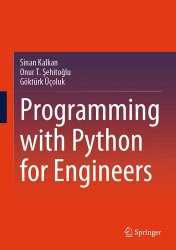Programming with Python for Engineers (2024)
- Добавил: literator
- Дата: 18-02-2025, 06:22
- Комментариев: 0
 Название: Programming with Python for Engineers
Название: Programming with Python for EngineersАвтор: Sinan Kalkan, Onur T. Şehitoğlu, Göktürk Üçoluk
Издательство: Springer
Год: 2024
Страниц: 295
Язык: английский
Формат: pdf (true), epub (true)
Размер: 93.5 MB
This book introduces computing and programming with undergraduate engineering students in mind. It uses Python (Version 3) as the programming language, chosen for its simplicity, readability, wide applicability and large collection of libraries. After introducing engineering-related Python libraries, such as NumPy, Pandas, Matplotlib, Sci-kit, Programming with Python for Engineers shows how Python can be used to implement methods common in a wide spectrum of engineering-related problems drawn from (for example): design, control, decision-making, scheduling and planning.
Important features of the book include the following:
The book contains interactive content for illustration of important concepts, where the user can provide input and by clicking buttons, trace through the steps.
Each chapter is also accessible as a Jupyter Notebook page and every code piece is executable. This allows the readers to run code examples in chapters immediately, to make changes and gain a better grasp of the concepts presented.
Target Audience of the Book:
This book is intended to be an accompanying textbook for teaching programming to science and engineering students with no prior programming expertise. This endeavor requires a delicate balance between providing in-depth details on computers and programming in a complete manner and the programming needs of science and engineering disciplines. With the hope of providing a suitable balance, the book uses Python as the programming language, since it is easy to learn and program with. Moreover, to keep the balance, the book is made up of three topics:
• The Basics of Computers and Computing (Chaps. 1–3): The book starts with the definitions of computation and an introduction to modern hardware and software infrastructure on which programming is commonly performed and the spectrum of programming languages.
• Programming with Python (Chaps. 4–9): These chapters present the basic building blocks of Python programming and continue with the ground formation for solving a problem in Python. Since almost all science and engineering libraries in Python are written with an object-oriented approach, a gentle introduction to this concept is also provided in this part.
• Using Python for Science and Engineering Problems (Chaps. 10–12): The book reserves the last chapters to practical and powerful tools that are commonly used in various science and engineering disciplines. These tools provide functionalities for reading and writing data from/to files, working with data (using e.g., algebraic, numerical or statistical computations) and plotting data. These tools are then utilized in example problems and applications at the end of the book.
Скачать Programming with Python for Engineers
Внимание
Уважаемый посетитель, Вы зашли на сайт как незарегистрированный пользователь.
Мы рекомендуем Вам зарегистрироваться либо войти на сайт под своим именем.
Уважаемый посетитель, Вы зашли на сайт как незарегистрированный пользователь.
Мы рекомендуем Вам зарегистрироваться либо войти на сайт под своим именем.
Информация
Посетители, находящиеся в группе Гости, не могут оставлять комментарии к данной публикации.
Посетители, находящиеся в группе Гости, не могут оставлять комментарии к данной публикации.
